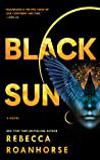
“Your father thought he could forbid me to wear this,” she said calmly enough, but the boy could hear the thread of pain in her voice, the places where deprivation and sorrow had left their cracks. “But your father doesn’t understand that this is the way of my ancestors, and their ancestors before them. He cannot stop a Carrion Crow woman from dressing to honor the crow god, particularly on a day as sacred as today.”
That’s a magical book. It’s got dark and beautiful worldbuilding, some absolutely bizarre and still somehow eminently relatable characters, and quite the cliffhanger of an ending (spoilers I suppose). Well worth reading.
The worldbuilding is absolutely wonderful. The new city / slum dichotomy is something we see over and over again, as is the conflict and bad blood between old gods and the new, between science and religion, but it’s particularly well done here.
We have viewpoints in both the Sun Priestess among the new, really trying to do something better with the city and a point of view among the old guard: the Carrion Crow, with ritual blinding and scarification.
I love the dichotomy between the sun and the dark, between the sky and the earth. Between good and evil–and just how hard it is to tell if either term ever really even applies. There’s just a lot to like in the worldbuilding. And that’s not to mention the other main plotline with a Teek woman–a people who apparently doesn’t have any need for men and can turn into mermaids under duress. It’s not even what I’d consider the main plot and it’s still fascinating.
It is declared that each of the great peoples who had entered into agreement here shall once a year send four children of the age of twelve from within their territory to serve under the Sun Priest in the city of Tova and reside in the celestial tower for a period of no less than sixteen years upon which they may return home should they choose; the exception being that the child be designated the head of their society whereby they shall serve another sixteen years; the exception being the child be designated the Sun Priest, whereby they shall serve unto death.
It’s all got a feel of the pre-colonial Americas taken decades or even centuries beyond where in our world the Europeans showed up, which has it’s own feel of something dark and beautiful that I really should seek out more of.
It is said that thousands of years ago our world was once populated with gods. They are our ancestors. But there was a great war, the God War, and many were killed. Those who were not killed in the war began to die anyway. Some say they were overcome with regret and withered, others say they lived, but they grew lonely and went into the far north, never to be seen again.
And still others say they returned to the sky, which was their home before they came to earth. Wherever their blood was spilled or their bodies lay, great wonders happened. Mountain ranges burst from flat lands, rivers gushed water like divine blood, stars were born in cataclysm. And in everything, they left bits of their power—the sun and stars, the creatures of earth and air, the very rocks and rivers and seas.
Once humans discovered that the objects, places, and creatures around them held power, they began to manipulate them for their own desires. Many societies call that witchcraft, pulling power from one source and putting it into another, usually an object for your own use like an amulet or a potion. The sorcery of the Cuecolans and the southern coasts is similar, only they also complement the power transfer through blood and sacrifice to achieve ends that witchcraft could not fathom.
The priests reject it all, saying that their study of the sun and stars is reason and not magic, but my old tutor believed it was not always so for them and the priests have only forgotten their magic.
The characters are all great. A young man, blinded and scarred by his own mother, trained to be an avatar of the crow god–and out on his own in the world for the first time. A woman from a culture of exotic seafaring women, exiled from home, on a job she can’t afford to miss. And a new sun priest just trying to do the right thing in a world that may not quite be ready for it.
One final point that I found interesting about the book was the inclusion / normalization of what seems to be an entire cast of nonbinary characters, including two that each play a fairly major part in one of the main character’s lives.
“A third gender, one I don’t believe you acknowledge here in this little backwater country. I am bayeki. But what should concern you more is that I am a Watcher.”
It’s an interesting thing that I haven’t read many stories with–especially with it being both a core part of the characters, but not the only or even main part of their plot. They’re complicated people (in both cases). It is interesting to see xe and xir pronouns in fiction. Since it’s not something I’ve seen much, they jump out on the page–which makes you realize just how often pronouns are used in normal text and how easily they fade into the background once you grow used to them.
Side note: I totally misread the Bingo category for this one. I thought it qualified for Hard Mode in the ‘Trans/Nonbinary character (hard mode: protagonist)’ category, but xe, while a major character, isn’t really a protagonist.